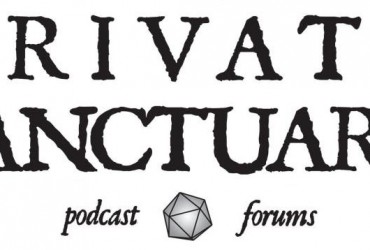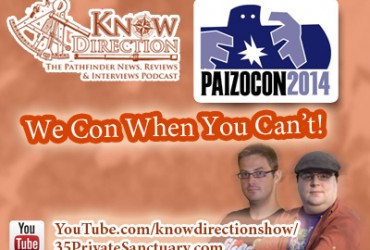Are you a new GM or a veteran looking for ways to improve your GMing skills? Take a peek Behind the Screens, a twice-monthly advice column dedicated to making you a better GM. A seasoned gamer and GM, Anthony Li offers his thoughts on all sorts of GM-related topics as well as in-depth reviews of published adventures by Paizo and 3rd party publishers.
Every GM prepares published adventures differently. Some GMs read the adventure cover to cover, over and over. Others skip straight to the read aloud text or the stat blocks and piece things together from there. For some GMs, especially those new to the role, preparing a published adventure can be a daunting task. Below are five questions that I ask myself while prepping a published adventure. I hope they’ll give some insight into how I approach running prewritten adventures for my players.
What’s going on?
The first thing I do is try and get a basic understanding of the adventure. What kind of adventure is it? What’s the focus? Are the PCs exploring an ancient dungeon? Are they tramping around the wilderness? Will the adventure be combat heavy or will there be an emphasis on roleplaying? If you’re preparing a Paizo adventure, you can usually get a pretty good idea of what to expect from reading the Adventure Summary and Background sections right in the beginning. Paizo does a pretty good job of outlining the adventure’s event arc and plot so you can use the summary as a guideline.
If an adventure summary isn’t provided then I would suggest skimming the adventure and assembling a rough outline yourself. At the very least try and get a good impression of what important plot points are going on just prior to the adventure start, what wheels are in motion necessary for the plot to unfold, and how the PCs are being affected. Getting a good handle on these important starting points will make it easier to hook your players into the story and continue to keep them motivated down the line.
What are the set pieces?
Published adventures are just like any other work of fiction. Their structure is formulaic. Identifying and understanding the parts of the narrative structure will allow a GM to better direct the flow of the adventure. Your players aren’t going to spend an equal amount of time on every encounter. Some encounters are going to take an hour or more. Others aren’t going to last more than a few minutes. Figuring out which encounters your players will spend more time on and be more excited about will help you to focus your preparation on can maximize your time energy.
So what are you looking out for? In a recent panel at PaizoCon, Owen K.C. Stephens suggests imagining that the adventure you’re running was a movie. When would the music change? When would the subtle background strings turn into a tense and rhythmic percussion? Those are the set piece encounters. Maybe the PCs have just bashed their way into the throne room of the goblin king. Or perhaps the PCs have cornered the villainous vizier and are aggressively persuading him to reveal his nefarious plot. Narrative set pieces tend to be the most exciting encounters in a published adventure. They deserve some extra attention.
Do the maps make sense?
I tend to be a visual gamer. Theater of the mind was great back in 2nd Edition. But the game’s progressed to the point where battle mats are fairly ubiquitous in published adventures. I’ve found that when I’m trying to figure out how a particular combat is supposed to work I go right to the map, even before the enemy statblocks. Where do the PCs start? Are there hazards I should watch out for? Are there any special rules for the area? If I know where the fight is supposed to take place then I can better visualize how the PCs and NPCs might move around it during the actual encounter.
Who are the major characters?
Adventure publishers tend to be pretty good about signaling which NPCs are the important ones. If an NPC has a unique statblock or there’s more than a paragraph of background chances are that we’re dealing with a major character. Familiarizing yourself with enemy statblocks is pretty standard. Getting a rough idea of the enemy’s numbers ahead of time will pay dividends once you actually run the combat. If the adventure includes a tactics section for enemy NPCs so much the better. Getting to know friendly NPCs is also greatly important. Friendly NPCs are going to be a GM’s primary way of interacting with PCs throughout a published adventure. Sure, there are bits of read aloud text here and there. But pretty much all of your plot and exposition will be told through the mouths of a friendly NPC.
How does the read aloud sound?
Most published adventures these days have read aloud text. This is usually bolded or italicized text that’s meant to be read to players as a way of detailing a room, area, or other location. Writing read aloud text is an art. Too short and there’s not enough description. Too long and you start to lose the interest of the players. Unfortunately many adventure authors can get carried away with read aloud text. I’ve seen scenarios with literally half a page of text that I’m expected to read to my players. Putting my players to sleep wasn’t really the way I’d intended to start that adventure.
So what do you do? Well there are a couple of things you could try. You could try cutting out extraneous information. Grab a highlighter. Focus on the key points. If the highlighted portions still flow well, great! If not then you might have to rewrite the read aloud. When doing this keep it short and to the point. Fifty words or so is a good length to get your point across. This isn’t very much space. This paragraph alone is already over eighty words!
So there you have it. I hope reading through this helps you better prepare a published adventure in the future. Do you have any thoughts or advice on preparing published adventures? Let us know in the comments below!
Anthony Li has been pretending to be someone or something else for about as long as he can remember, which some people might consider a problem. He cut his teeth on 2nd Edition AD&D when he was 14 years old and his only regret is that he didn’t start rolling dice sooner. Due to an unhealthy addiction to Magic: the Gathering he missed the entire cultural phenomenon that was the 3.X era of D&D. After a brief stint with 4E, he was dragged kicking and screaming into the Pathfinder Roleplaying Game where he has since acclimated, adapted, and thrived. Most of his roleplaying experience has been behind the GM screen where he has trained his dice to confirm crits on command. He always roots for the bad guys.







Leave a Reply